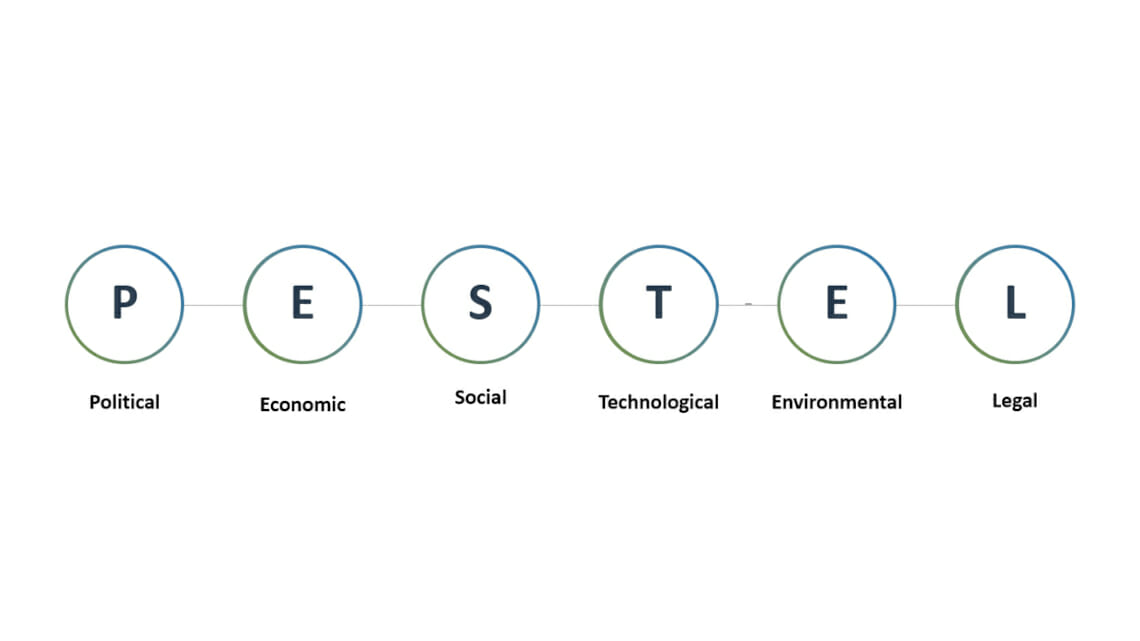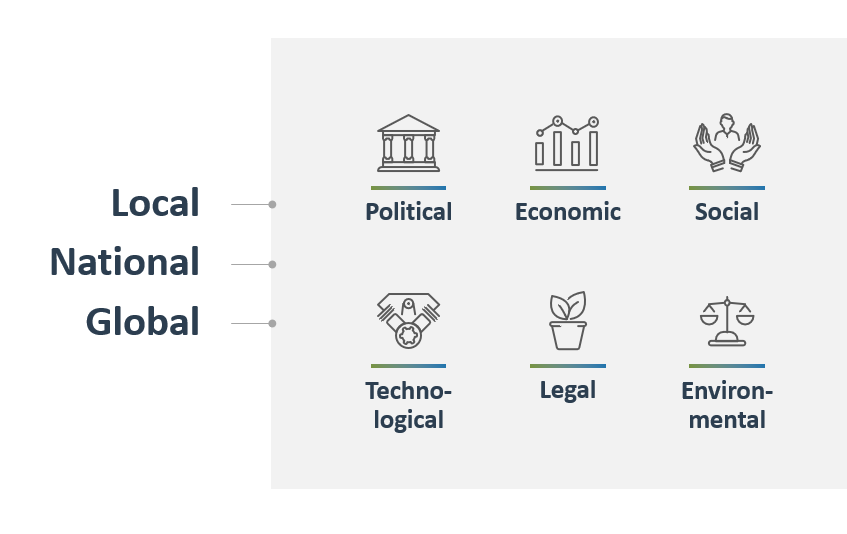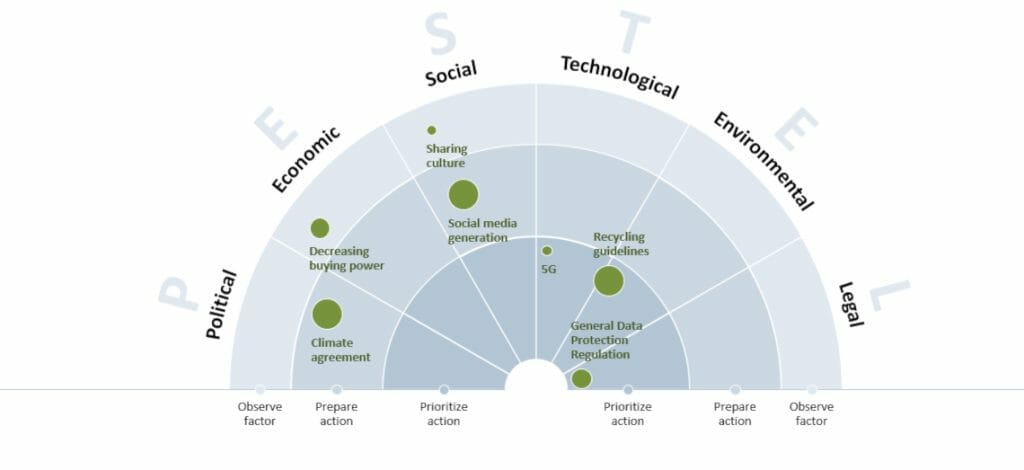
Analyze External Business Influences with the PESTEL Analysis!
You work in a company or are about to start one? Then you should consider various conditions and external factors for the success of your idea/product.
This is where the PESTEL analysis comes into focus. By strategically examining the macroeconomic environment of your company, you can gain an overview of the market situation. Today, we will explain how the PESTEL analysis works, what its foundations are, and which factors are precisely examined.
What is the PESTEL analysis?
The PESTEL analysis (also known as STEP analysis) is a qualitative and quantitative method of company analysis. This analysis method examines and evaluates the most important external influences on the company. The influences are categorized into the six PESTEL categories.
The term PESTEL is an acronym, with each initial letter representing one of the six factors of analysis:

These influence categories provide comprehensive insights into the opportunities and challenges for projects and other business matters.
Advantages and disadvantages of the PESTEL method
The PESTEL analysis is a popular method that allows for a comprehensive analysis of the business environment of a company. However, this method has both advantages and disadvantages:
It is important to carefully consider whether the advantages or disadvantages of the method outweigh each other for your specific company.
Which areas can benefit from the PESTEL analysis?
The PESTEL analysis finds its application in project management. When used correctly, it can gather important information for project planning and implementation.
Numerous other areas can also benefit from the PESTEL analysis. For example, it is used in product development and marketing management. As a general decision-making tool, it provides valuable information that needs to be considered in decision-making processes
The PESTEL analysis is also significant for corporate compliance. It summarizes the legal environment, including laws and regulations, and provides support for their compliance.
What are the objectives of the PESTEL analysis?
The main objective of the PESTEL analysis is to adapt a company’s strategies to new circumstances or changes. It focuses on external factors that can influence the company’s strategy and decision-making process. With the PESTEL analysis, you can uncover the following answers:
PESTEL Analysis: The 6 Factors in Detail
Here, we explain in more detail the six macroeconomic categories of the PESTEL analysis.
- Political Factors
Political factors play a significant role, especially when considering the location of your company. These factors can provide great opportunities, but they can also serve as exclusion criteria. For example, an unstable political system could have a lasting impact on your company.
The influencing factors in this category include:
Application Example:
A company from a non-EU country wants to invest in Germany. Germany is a member of the European Union. Therefore, the company needs to consider both German and EU regulations in its planning.
- Economic Factors
Your company needs to operate economically and be successful. The economic factors of the chosen business location play a crucial role in this regard. The focus here is on analyzing the potential market and the purchasing power of the target customer group.
The following aspects are considered:
Application Example:
The purchasing power of the German population has increased due to a continuously rising standard of living. Consumers are willing to spend more money on goods.
- Socio-cultural Factors
Depending on the chosen location, there may be differences in culture and social structure. These differences can extend beyond national and continental borders. As a business owner, you must be aware that other cultures may not necessarily resemble the German culture we are familiar with. Therefore, you need to assess whether other locations are suitable for your business.
Socio-cultural factors include:
Application Example:
A company based outside Germany that wants to establish a presence in Germany needs to consider language barriers. English often functions as a lingua franca, but for a successful company, it is important to offer services in the local language as much as possible.
- Technological Factors
Technological conditions should also align with your company’s strategy. Technological aspects play a significant role, especially in choosing the business location.
The following technological factors are considered:
Application Example:
Germany has excellent infrastructure, making it easy for locally-based companies to ensure safe and efficient transportation and distribution of goods.
- Environmental-Geographical Factors
These factors focus on environmental influences that can affect your company. They include:
Application Example:
Climate change is a widely discussed topic, and consumers are increasingly concerned about sustainability. As a result, you should ensure sustainability in your production to guarantee sales.
- Legal Factors
Your company must comply with the legal rules of the country and be legally protected. These rules may vary depending on the chosen locations. Essentially, two legal systems must be distinguished:
- Common Law (based on precedents and important past judgments)
- Code Law or Civil Law (based on legal codes) The following factors belong to this category:
Application Example:
In Germany, for example, there are very strict legislations that international companies must comply with.
Alternative Methods: PEST, LoNGPESTLE, STEP Analysis
Within the PESTEL analysis, there are various variations for different circumstances. For example, the STEP analysis, also known as PEST analysis, only analyzes four out of the six categories.
On the other hand, the LoNGPESTLE analysis examines the categories on different levels, taking into account local, national, and global factors. The choice of which analysis variant is appropriate depends on the specific situation being analyzed and personal preference.

How to Conduct a PESTEL Analysis: 4 Steps
If you have decided to use the PESTEL analysis, follow these four steps to conduct it:
- Identify the most important influencing factors for your company.
As listed above, there can be numerous influencing factors. Go through them thoroughly and make a list of the ones that are highly important for your company. Categorize them according to the six factors. - Define the topics.
Before conducting the analysis, clarify how you will define the selected topics. Determine how you will calculate the necessary metrics. This will ensure that there is a shared understanding and consistent approach within your company. - Conduct research.
After defining the topics, begin the research process. Gather all the data as accurately as possible. For some factors, you may encounter incomplete data, and in such cases, you will need to make the most precise estimations. - Analyze the factors and their impact on your company.
Now, you need to analyze the collected data in relation to your company. Identify which categories have a positive, neutral, or negative impact on your company. Based on this analysis, derive future strategic steps for your company.
Visualize the PESTEL Analysis in PowerPoint
With the help of PowerPoint, you can present the results of your PESTEL analysis in a visually appealing way. Visual representations make it easier to understand your findings and their connections to your company.
Feel free to use templates from PresentationLoad for your PESTEL analysis in PowerPoint!

This is what a possible completed PESTEL analysis with PowerPoint might look like:

Conclusion: Analyze important business influences with the PESTEL analysis
Whether you are a startup founder or an existing company looking to expand, rely on the PESTEL analysis. With this easy-to-use method, you can analyze important external influences on your company and align your business accordingly. This ensures the profitability of your company.
If you have any questions about the PESTEL analysis or PowerPoint in general, do not hesitate to contact us at [email protected]. We are happy to assist you!
Are you looking for visually appealing and professionally designed slide templates? Browse our shop. We offer a wide range of slides prepared for various (business) topics that you can download. Visit our shop today! ►Go to Shop
You may also be interested in these articles:




